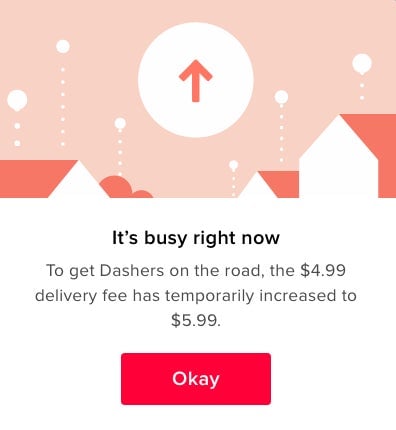Uber’s least popular feature is now all over food delivery apps
Everyone hated surge pricing when Uber first added it to rides. Now surge is becoming ubiquitous among food delivery startups, too.

Everyone hated surge pricing when Uber first added it to rides. Now surge is becoming ubiquitous among food delivery startups, too.
Postmates has “blitz pricing” and Sprig, before it went out of business, charged more to deliver during busy times. Uber brought surge pricing to UberEats late last year and, in recent months, DoorDash has quietly begun testing dynamic delivery fees as well.

A handful of DoorDash customers have recently spotted the San Francisco-based delivery startup increasing its fees when demand is high. Twitter user “Indigo Sky Tomato” in late June posted a screenshot from DoorDash that read, “It’s busy right now.” The notification said a $6.99 delivery fee was being “temporarily increased” to $9.99. Another person in mid-June tweeted a screenshot of DoorDash raising its delivery fee to $4 from $0. “Doordash with surge pricing surcharge of ∞%,” the person captioned the photo.
DoorDash spokesman Eitan Bencuya told Quartz that the company has been testing dynamic delivery fees in “select markets” since February, most recently the San Francisco Bay Area, parts of Los Angeles, Chicago, and Phoenix.
DoorDash is one of several Silicon Valley startups jockeying to deliver food from restaurants and stuff from convenience stores. Venture capitalists have poured billions into these startups in recent years in hopes of catching the next big on-demand success story—Uber, but for food. DoorDash was founded in 2013 and valued at about $600 million when it last raised money from investors in March 2016. The company charges delivery fees that range from 99 cents to $7.99 plus a service fee of 7% to 15% on every order.
Companies that hire independent contractors—like DoorDash, Uber, and Postmates—like surge pricing because it helps them encourage their workers to come online during busy periods. You can’t tell an independent contractor when to work, as it risks being deemed “employer-like” by a court, but you can give them a nudge by offering to pay more during certain hours. Uber uses a variety of incentives, including surge pricing, to get drivers on the road when it needs them most.
Customers, on the other hand, have grown somewhat accustomed to surge pricing thanks to Uber, but generally speaking they still don’t like it. That’s understandable: Who wants to pay an extra $4 to get a burger during the lunch rush? You might bite the bullet with rides—for example, if you really need a car to get to the airport—but it’s less clear how many people will do the same to get a meal, especially when they could easily order the same thing on another app. Thanks to venture capitalists, those of us who live in cities these days have plenty of food delivery options.